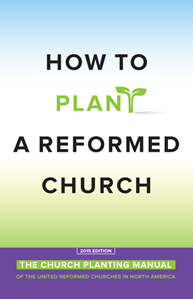Book Review: How to Plant a Reformed Church


How to Plant a Reformed Church, The Missions Committee of the United Reformed Churches of North America, 2015. Paperback, 104 pages.
As the title suggests, this is a practical guide for Reformed church planting. It comes from the United Reformed Churches of North America (URCNA). Many of my readers are familiar with the URCNA. For those who are not, this federation of churches emerged out of the 1990s-era Christian Reformed Church. As the CRC drifted away from Scripture on issues like women in office, faithful Reformed believers headed for the exits. As a new confessionally Reformed federation came into existence, there was also an eagerness amongst many of these believers to be outward looking. Church planting and missions was in the DNA of the URCNA from the start. Especially in the United States, some of their instituted churches date back to church plants begun in the 2000s.
Fast forward to the 2010s and discussions were taking place about how to collate lessons learned from these early endeavours. Could the URCNA Missions Committee put together a resource that would help churches better do the work of church planting? The Orthodox Presbyterian Church had developed their own guide: Planting an Orthodox Presbyterian Church (you can find it here). When I was a missionary, I found that manual incredibly helpful, even though I’m not a Presbyterian. Many lessons learned in the OPC are transferable to other contexts, even to the type of cross-cultural work I was doing. Some URCNA church planters discovered the same, but also saw the need to develop a resource that would be more explicitly aligned with URCNA beliefs (the Three Forms of Unity) and church government. That led to this little book.
There are many helpful insights in How to Plant a Reformed Church. How do you decide when it’s time to plant a church? Where should you plant a church? How should it be overseen? How do you promote the church plant in the community it’s placed? When do you know that it’s time to institute the church? What’s the role of the classis? All these are questions addressed here. There are also five appendices with teaching materials for church plants. They cover topics like: “What is Church Membership and Why Is It Necessary?” and “What is Reformed Worship?” As a pastor in the Free Reformed Churches of Australia, I think much of this could be transferable to our context here, and equally to the Canadian Reformed Churches. I’m sure that others in different contexts could also make use of the wisdom in this book.
Besides the practical bent, I also appreciate the emphasis on developing a confessional ethos in church planting. The title says How to Plant a Reformed Church, and ‘Reformed’ there means unabashedly confessional. This approach has nothing to do with the bait-and-switch model — i.e. attracting people by pretending to be something other than Reformed. Like the OPC manual, this book emphasizes beginning with the end in mind. If we want a truly Reformed church, then the approach needs to be confessionally Reformed from the get go. The book explains how.
If it’s not obvious, I have high praise for this resource. I hope it not only gets read, but that it stimulates Reformed churches, URCNA and otherwise, to continue giving attention to the spread of the gospel. After all, that’s a principal reason behind the existence of the church. We’re here to proclaim Christ crucified and be God’s instruments to see more people worship him in churches everywhere.
A free electronic copy of How to Plant a Reformed Church is available here.


